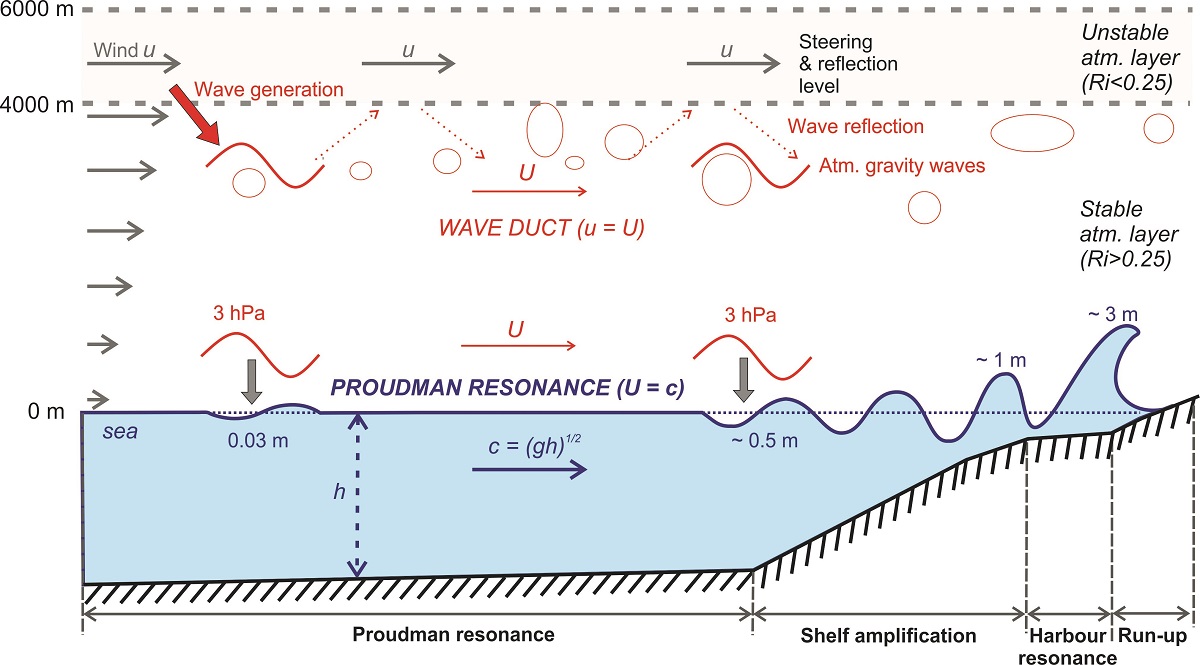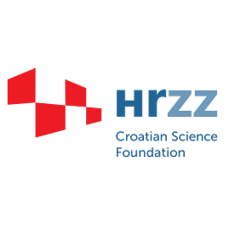Meteorological tsunamis
Meteorological tsunamis (meteotsunamis) are rare but hazardous long ocean waves, which have the same frequencies and spatial scales as tsunami waves. Meteotsunamis are, however, not related to seismic activity, volcanic explosions or submarine landslides, but to atmospheric forcing: pressure jumps, atmospheric gravity waves, frontal passages, squalls, etc. More often than not, the atmospheric forcing processes are relatively weak, and the generation of pronounced waves in the sea depends on the resonant transfer of energy from the atmosphere to the sea.
Two types of resonance have been found to play role: Proudman resonance (Proudman, 1929) and harbour resonance (Honda et al., 1908). Proudman resonance occurs when speed of atmospheric forcing matches speed of long-ocean waves; and harbour resonance occurs when frequency of incoming long-ocean waves equals frequency of seiches in stricken harbour.

Meteotsunami generation processes are illustrated in Figure 1 (taken from Šepić et al., 2015a). Numerous atmospheric gravity waves (represented by bubbles) are generated at the interface of unstable and stable atmospheric layer at places of strong wind shear. Air pressure change (a surface manifestation of atmospheric gravity waves) generates long-ocean waves which can be amplified through several processes: (1) Proudman resonance (due to matching of long-ocean waves speed and speed of atmospheric gravity wave); (2) shelf amplification (due to shoaling); and (3) harbour resonance (due to matching of frequency of incoming long-ocean waves and harbour eigenfrequencies). Incoming ocean waves can be amplified more than 100 times before hitting the coast as a destructive meteotsunami.
Destructive meteotsunamis are known to occur in Japan (Hibiya and Kajiura, 1982), Spain (Jansà et al., 2007), Great Lakes (Donn and Ewing, 1956), China (Wang et al., 1987), the eastern coast of the USA (Sallanger et al., 1995; Paxton and Sobien, 1998) and other locations (Monserrat et al., 2006). The eastern coast of the Adriatic Sea is among the world locations especially endangered by meteorological tsunamis.
Furthermore, the strongest of the Adriatic events, the Great Vela Luka Flood of 21 June 1978, is likely the strongest known meteotsunami in the world: tsunami-like waves with trough-to-crest heights of up to 6 m and periods of about 20 min suddenly appeared, resulting in one of the greatest marine natural disaster in the modern history of Croatia with estimated damage of 7 million US dollars at that time, a quarter of annual income of the whole island of Korčula (Vučetić et al., 2009). Aside for the Great Vela Luka Flood, there appears to have been a number of other meteotsunamis in the Adriatic Sea: from the ones remembered only in local legends to the ones extensively researched.




